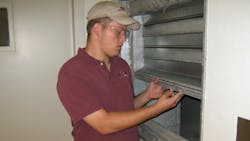Motorized Fire and Smoke Dampers
The reliability and effectiveness of sprinklers often is used to justify the removal of requirements for fire and smoke dampers from model building codes. However, there is ample evidence smoke is the major killer in building fires and that it causes injury, sickness, and property damage. A 1997 National Fire Protection Association study1 found a significant percentage of fires in sprinklered and non-sprinklered buildings resulted in smoke damage beyond the fire floor. If an automatic sprinkler system failed and there were no smoke dampers in a building, smoke spread most certainly would increase.
Instead of the elimination of damper requirements, Air Movement and Control Association (AMCA) International advocates the switch from fusible-link dampers to motorized dampers, which reduces long-term testing costs and enables HVAC functionality that could reduce first cost.
Testing Costs
In the United States, The Joint Commission, state fire marshals, and other authorities having jurisdiction require testing of fire and smoke dampers at specified intervals. NFPA 80, Standard for Fire Doors and Other Opening Protectives, which covers fire and combination fire/smoke dampers, and NFPA 105, Standard for the Installation of Smoke Door Assemblies and Other Opening Protectives, which covers smoke dampers, require inspection and testing one year after installation and every four years thereafter, the exception being dampers for hospitals, which are to be inspected and tested every six years. Per NFPA 92, Standard for Smoke Control Systems, smoke dampers in dedicated systems are to be tested at least semi-annually, while those in non-dedicated systems are to be tested at least annually. NFPA 72, National Fire Alarm and Signaling Code, provides requirements for periodic testing of smoke-control systems; dampers must be cycled as part of this testing.
For motor-operated dampers, UL 555, Standard for Fire Dampers, and UL 555S, Standard for Smoke Dampers, require a factory-mounted electric or pneumatic actuator as part of the damper assembly. The damper assembly can be equipped with an optional position-indicating device. Such devices are comprised of a set of two single-pole/double-throw auxiliary switches that can be wired to a local or remote-control panel or a building automation system (BAS). They are used to indicate if a damper’s blades are in one of three positions: fully open, fully closed, or neither.
AMCA International’s “Guide for Commissioning and Periodic Performance Testing of Fire, Smoke and Other Life Safety Related Dampers”2 provides procedures for testing motorized dampers. These tests can be performed without physically accessing ductwork or penetrations where dampers are installed. With fusible-link-type dampers, physical-access requirements are what drive up testing costs.
Fire/Smoke Dampers in Ventilation Systems
The cost-effectiveness of fire/smoke dampers is improved by their ability to perform multiple functions in a ventilation system. For example, they can be equipped with balancing or modulating actuators in lieu of standard two-position spring-return actuators. With a balancing actuator, a single assembly accomplishes the tasks of three dampers:
- Balancing: The actuator contains an integral rotation limiter to balance airflow in ducts.
- Smoke: When a signal is detected via a normally closed smoke-detector connection, a damper in smoke-control mode will close and remain closed until the signal ceases.
- Fire: A UL-classified heat-responsive device, usually a resettable bimetallic limit switch, is activated upon detection of elevated temperature, and the damper closes to prevent the spread of fire.
Similarly, a fire/smoke damper with a modulating actuator can function as a control damper. In normal non-emergency HVAC mode, an actuator can receive a signal from a BAS and control airflow in response to system design conditions.
Conclusion
Fire, smoke, and combination fire/smoke dampers are an integral part of a complete life-safety system. Motorized dampers reduce first costs, as well as long-term maintenance and testing costs. Motorized dampers can be tested without physical access, and they can provide HVAC functionality over and above their fire/life-safety service.
References
1) Ahrens, M. (1997). Special analysis–Sprinkler status and the extent of flame and smoke damage in high-rise and mid-rise structure fires reported to u.s. public fire departments 1986–1995. Quincy, MA: NFPA.
2) AMCA. (2011). Guide for commissioning and periodic performance testing of fire, smoke and other life safety related dampers. Arlington Heights, IL: AMCA International. Available at http://bit.ly/AMCA_Cx
Did you find this article useful? Send comments and suggestions to Executive Editor Scott Arnold at [email protected].

